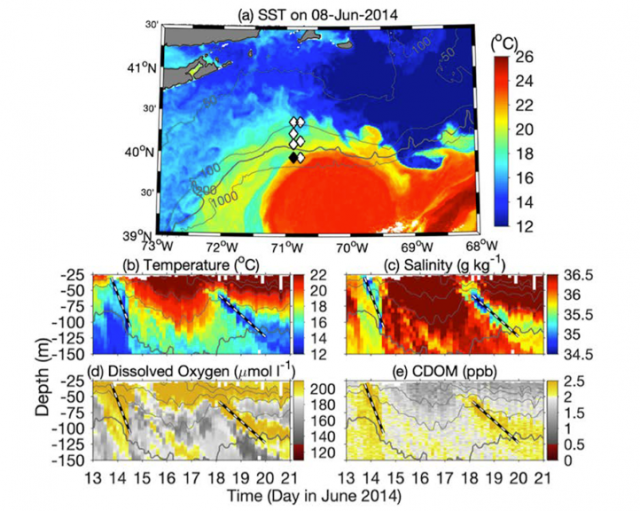Shelf Water Subduction and Cross-Shelf Exchange
Weifeng (Gordon) Zhang, Applied Ocean Physics & Engineering, Woods Hole Oceanographic Institution, Woods Hole, MA, USA. Extracted from OOI Science Plan, 2021.
The Mid-Atlantic Bight (MAB) continental shelf off the US northeast coast is a region of high biological productivity and economic importance (Sherman et al., 1996). A persistent shelfbreak front separates the cold fresh shelf water from the waters in the Slope Sea (Linder and Gawarkiewicz, 1998) and helps maintain the shelf biological productivity. Gulf Stream warm-core rings can break the shelfbreak front and induce major water exchange across the shelfbreak. A warm-core ring impinging on the shelfbreak could draw a substantial amount of shelf water offshore, forming a shelf water streamer a filament of shelf water moving into the Slope Sea (e.g., Joyce et al., 1992). Shelf water streamers, characterized by low surface temperature, can be distinctively identified in satellite data. The streamers carry salt, nutrients, and carbon across the shelf edge and affect water characteristics and biological production in the continental shelf and Slope Sea (Vaillancourt et al., 2005). In recent years, the Gulf Stream in the Northwest Atlantic has become increasingly unstable (Andres, 2016) and sheds more rings in the Slope Sea (Gangopadhyay et al., 2019). It is thus imperative to study how warm-core rings are affecting cross-shelf exchange at the MAB shelfbreak and modifying the water properties and biological productivity on the continental shelf.
Studies of shelf water streamers in the past had focused on their surface expression, and their subsurface structure was largely unknown, due to the lack of in situ measurements. Meanwhile, historical observations have shown isolated subsurface pockets of shelf water in the Slope Sea on the ring periphery, separated from surface- visible shelf-water streamers (e.g., Kupferman and Garfield, 1977). Thus, warm-core rings might have induced subsurface offshore transport of the shelf water with no surface expression. The dynamics of the possible subsurface transport and its connection to the surface-visible shelf water streamer were unclear. To quantify the total offshore transport of the shelf water induced by rings, information on the vertical structure of the transport is crucial.
The OOI Pioneer Array (Gawarkiewicz and Plueddemann, 2018) at the MAB shelf edge provides a unique opportunity for studying subsurface offshore transport of the shelf water. One example is that Pioneer Array moored profilers and gliders captured clear signals of frontal subduction of the shelf water on the edge of an impinging warm- core ring in June 2014 (Zhang and Partida, 2018). The data showed a layer of cold, less-saline, high- oxygen and high-CDOM shelf water moving downward underneath a surface layer of ring water, as highlighted by the striped black lines in Figure to the right. The subducted shelf water is carried offshore by the anticyclonic ring flow underneath a surface layer of ring water and is invisible on the ocean surface. It represents a form of offshore transport of the shelf water that had not been realized previously. The water mass characteristics captured by Pioneer Array allowed the development of an ocean model to study the dynamics of the frontal subduction and to quantify the surface-invisible part of the shelf-water offshore transport.
Through combining Pioneer Array data, satellite data, and an ocean model, we revealed that the submesoscale frontal subduction results from the onshore migration of the ring that intensifies the density front on its interface with the shelf water. The subduction is a part of the cross-front secondary circulation trying to relax the intensifying front. Offshore transport of the subducted shelf water by the ring flow explains historical observations of isolated subsurface packets of shelf water in the Slope Sea. Model- based estimates suggest that the surface-invisible transport could be a major part of the overall shelf-water offshore transport induced by warm-core rings. The offshore transport of the subducted shelf water directly affects the distribution of heat, salt, nutrients and oxygen across the shelf edge. Future analysis of the Pioneer Array data should focus on providing a more robust quantification of the cross-shelf exchanges at the shelfbreak and the influence of warm-core rings on the physical and biological properties of the MAB continental shelf.

